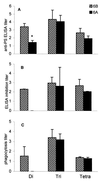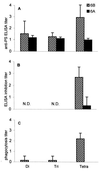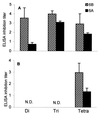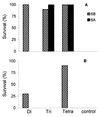Synthetic 6B di-, tri-, and tetrasaccharide-protein conjugates contain pneumococcal type 6A and 6B common and 6B-specific epitopes that elicit protective antibodies in mice
- PMID: 11159969
- PMCID: PMC97953
- DOI: 10.1128/IAI.69.2.787-793.2001
Synthetic 6B di-, tri-, and tetrasaccharide-protein conjugates contain pneumococcal type 6A and 6B common and 6B-specific epitopes that elicit protective antibodies in mice
Abstract
The immunogenicity and protective capacity of Streptococcus pneumoniae 6B capsular polysaccharide (PS)-derived synthetic phosphate-containing disaccharide (Rha-ribitol-P-), trisaccharide (ribitol-P-Gal-Glc-), and tetrasaccharide (Rha-ribitol-P-Gal-Glc-)-protein conjugates in rabbits and mice were studied. In rabbits, all saccharides conjugated to keyhole limpet hemocyanin (KLH) evoked high levels of pneumococcal (Pn) type 6B antibodies that facilitated type-specific phagocytosis. Unlike the disaccharide rabbit antisera, tri- and tetrasaccharide rabbit antisera also reacted with 6A PS in an enzyme-linked immunosorbent assay (ELISA) and promoted phagocytosis of 6A pneumococci. All these rabbit antisera passively protected mice against a Pn 6B challenge. The disaccharide conjugate-induced antiserum, however, failed to protect mice against a 6A challenge. In mice, phagocytic and protective anti-Pn 6B antibodies were only induced by the tetrasaccharide conjugate and not by PS 6B or PS 6B-protein conjugates. These antibodies did not cross-react with 6A PS in ELISA and were unable to phagocytize 6A pneumococci. In conclusion, the disaccharide and tetrasaccharide conjugates already contain epitopes capable of inducing 6B-specific, fully protective antibodies in rabbits and mice, respectively.
Figures






Similar articles
-
Cross-reactivity of antibodies to type 6B and 6A polysaccharides of Streptococcus pneumoniae, evoked by pneumococcal conjugate vaccines, in infants.J Infect Dis. 2001 Sep 15;184(6):789-93. doi: 10.1086/322984. Epub 2001 Aug 14. J Infect Dis. 2001. PMID: 11517443
-
Epitope specificity of rabbit immunoglobulin G (IgG) elicited by pneumococcal type 23F synthetic oligosaccharide- and native polysaccharide-protein conjugate vaccines: comparison with human anti-polysaccharide 23F IgG.Infect Immun. 1994 Mar;62(3):799-808. doi: 10.1128/iai.62.3.799-808.1994. Infect Immun. 1994. PMID: 7509318 Free PMC article.
-
Avidity, potency, and cross-reactivity of monoclonal antibodies to pneumococcal capsular polysaccharide serotype 6B.Infect Immun. 2001 Jan;69(1):336-44. doi: 10.1128/IAI.69.1.336-344.2001. Infect Immun. 2001. PMID: 11119522 Free PMC article.
-
Higher Cytokine and Opsonizing Antibody Production Induced by Bovine Serum Albumin (BSA)-Conjugated Tetrasaccharide Related to Streptococcus pneumoniae Type 3 Capsular Polysaccharide.Front Immunol. 2020 Dec 4;11:578019. doi: 10.3389/fimmu.2020.578019. eCollection 2020. Front Immunol. 2020. PMID: 33343566 Free PMC article.
-
Production of antisera to synthetic peptides.Methods Mol Biol. 1994;32:389-99. doi: 10.1385/0-89603-268-X:389. Methods Mol Biol. 1994. PMID: 7951738 Review. No abstract available.
Cited by
-
Synthetic Analogs of Streptococcus pneumoniae Capsular Polysaccharides and Immunogenic Activities of Glycoconjugates.Russ J Bioorg Chem. 2021;47(1):1-25. doi: 10.1134/S1068162021010076. Epub 2021 Mar 20. Russ J Bioorg Chem. 2021. PMID: 33776393 Free PMC article.
-
Concise synthesis of a heptasaccharide antigen found in the cell-wall lipopolysaccharide of Mycobacterium gordonae strain 990.Glycoconj J. 2008 Dec;25(9):817-26. doi: 10.1007/s10719-008-9142-8. Epub 2008 Jun 21. Glycoconj J. 2008. PMID: 18568400
-
Synthesis of propargyl glycosides of Streptococcus pneumoniae serotypes 6A and 6B for glycoconjugate vaccines.Tetrahedron. 2024 Sep 28;165:134186. doi: 10.1016/j.tet.2024.134186. Epub 2024 Aug 8. Tetrahedron. 2024. PMID: 39280115
-
Identification of a simple chemical structure associated with protective human antibodies against multiple pneumococcal serogroups.Infect Immun. 2009 Aug;77(8):3374-9. doi: 10.1128/IAI.00319-09. Epub 2009 May 18. Infect Immun. 2009. PMID: 19451241 Free PMC article.
-
The Effect of a BSA Conjugate of a Synthetic Hexasaccharide Related to the Fragment of Capsular Polysaccharide of Streptococcus pneumoniae Type 14 on the Activation of Innate and Adaptive Immune Responses.Front Immunol. 2016 Jun 24;7:248. doi: 10.3389/fimmu.2016.00248. eCollection 2016. Front Immunol. 2016. PMID: 27446078 Free PMC article.
References
-
- Alonso De Velasco E, Verheul A F M, van Steijn A M P, Dekker H A T, Feldman R G, Fernandez I M, Kamerling J P, Vliegenthart J F G, Verhoef J, Snippe H. Epitope specificity of rabbit immunoglobulin G (IgG) elicited by pneumococcal type 23F synthetic oligosaccharide- and native polysaccharide-protein conjugate vaccines: comparison with human anti-polysaccharide 23F IgG. Infect Immun. 1994;62:799–808. - PMC - PubMed
-
- Alonso De Velasco E, Verheul A F M, Veeneman G H, Gomes L J F, van Boom J H, Verhoef J, Snippe H. Protein-conjugated synthetic di- and trisaccharides of pneumococcal type 17F exhibit a different immunogenicity and antigenicity than tetrasaccharide. Vaccine. 1993;11:1429–1436. - PubMed
-
- Borgono J M, Mclean A A, Vella P P. Vaccination and revaccination with polyvalent pneumococcal polysaccharide vaccines in adults and infants. Proc Soc Biol Med. 1978;157:148–154. - PubMed
-
- Breiman R F, Butler J C, Tenover F C, Elliott J A, Facklam R R. Emergence of drug-resistant pneumococcal infections in the United States. JAMA. 1994;271:1831–1835. - PubMed
MeSH terms
Substances
LinkOut - more resources
Full Text Sources
Other Literature Sources

